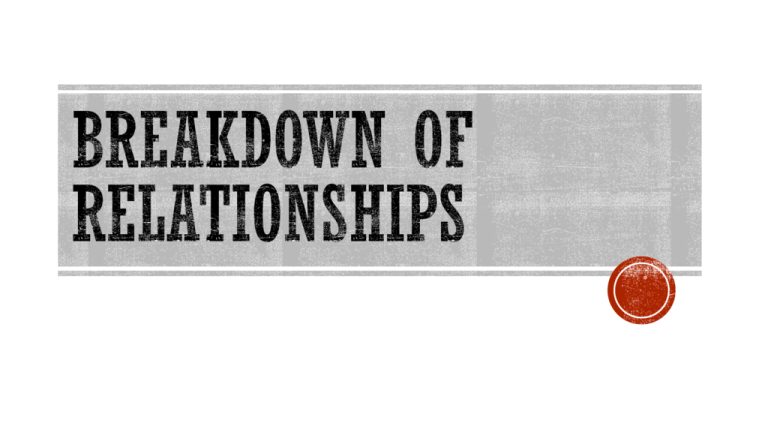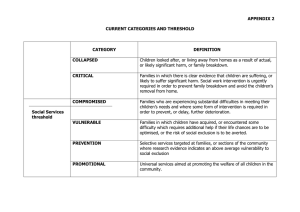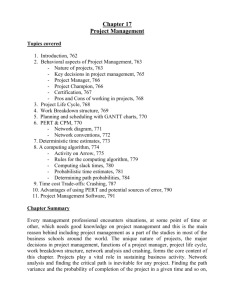Breakdown_of_relatinships
advertisement

We will go over the breakdown of relationships You will then have an opportunity for verbal feedback With a partner, discuss relationships that you ended Q: Were there common reasons, or was each one different? Now, discuss relationships that ‘they’ ended Q: Were there common reasons, or was each one different ● Conflict ● Breaking agreed rules [fidelity, confidentiality, support] ● Dissatisfaction / boredom ● Lack of stimulation / novelty ● An attractive alternative relationship ● Costs outweighing rewards ● Perceived changes in relationship ● Interference from other relationships ● Problems of abuse [alcohol, monetary, sex] ● Changes in self or other person ● Falling out of love ● Saving face Premarital breakdown... ● LEE 1984 interviewed couples FOUND: 5 stages of premarital breakdown 1. dissatisfaction – realising you're unhappy 2. exposure – difficulties coming to surface / voiced 3. negotiation – discussing issues / deciding how to save it 4. attempted resolution – trying solutions 5. termination – realising it isn't working – ending relationship STRENGTH ● Research was qualitative & subjective WEAKNESS ● Qualitative data not scientific – interpretation difficult, bias ● Subjective nature of data – difficult to generalise ● Retrospective data ● ● Samples – long term cohabiting couples only used [married, friends may be different] individual differences not accounted for in exposure stage – not everyone discusses dissatisfaction with partner before ending ● Similar to Lee's BUT can be applied to ALL relationships ● 4 phases 1. intrapsychic – thinking about negative aspects of partner & relationship BUT NOT discussing them (yet!) Threshold - “I can't stand this anymore” ...Dissatisfaction grows = can't hold in feelings dyadic phase – confronting partner & trying to resolve problems Threshold - “I'd be justified in withdrawing” ...partner knows how you feel, if they don't help resolve issues you feel like giving up [corresponds with Lee's exposure,negotiation & resolution attempt stages] social phase – decide what to do now relationship effectively over includes face-saving & negotiating social implication, e.g. childcare, friends] Threshold - “I mean it” [corresponds with Lee's termination stage] relationship aired publicly, for some people this process may save relationship...if not... grave-dressing phase – focus on communicating socially acceptable account of end of relationship [important!] Threshold - “Now it's inevitable”' Deciding what relationship will be with ex & where blame lies [helps get over it] ● ● ● Both models have useful practical applications – can identify stage of breakdown & suggest ways to attempt to repair relationship Models suggest how, once broken, couples in intrapsychic phase should aim to reestablish liking by focusing on positive aspects Neither model explains why relationships breakdown – merely focuses on likely sequence of events Duck found factors make breakup more likely... ● Younger than average partners – teen wedding Lower socio-economic group / educational level






